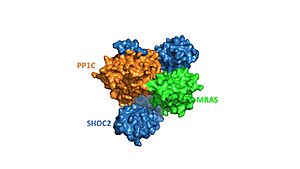Sandbox Reserved 1777
From Proteopedia
(Difference between revisions)
| Line 3: | Line 3: | ||
<StructureSection load='7pui' size='350' side='right' caption='SHOC2-PP1C-MRAS (PDB entry [[7pui]])' scene='95/952704/Smpcolored/1'> | <StructureSection load='7pui' size='350' side='right' caption='SHOC2-PP1C-MRAS (PDB entry [[7pui]])' scene='95/952704/Smpcolored/1'> | ||
=Introduction= | =Introduction= | ||
| - | SHOC2-PP1C-MRAS is a human enzyme that is involved in regulating cell proliferation and division<Ref name='Astrain'>Bernal Astrain G, Nikolova M, Smith MJ. Functional diversity in the RAS subfamily of small GTPases. Biochem Soc Trans. 2022 Apr 29;50(2):921-933. doi: 10.1042/BST20211166. [https://doi.org/10.1042/BST20211166. DOI:10.1042/BST20211166]. </Ref>. The enzyme is involved in the vast RAS-MAPK pathway, which is initially activated by an extracellular growth factor binding to a membrane bound RAS [https://www.mechanobio.info/what-is-mechanosignaling/what-are-small-gtpases/what-are-ras-gtpases/. GTPase.] such as HRAS, NRAS, or KRAS. RAS-GTPases are a family of proteins that work by functioning as molecular switches[https://www.frontiersin.org/articles/10.3389/fonc.2019.01088/full#:~:text=In%20human%20cells%2C%20three%20closely,proliferation%20and%20survival%20among%20others]. This occurs from the protein alternating between binding GTP to be active and GDP to be inactive <ref name="Astrain" />. After activation via an extracellular growth factor, the RAS-GTPase enzyme binds GTP, which activates RAF<Ref name='Molina'>Molina JR, Adjei AA. The Ras/Raf/MAPK pathway. J Thorac Oncol. 2006 Jan;1(1):7-9. [https://doi.org/10.1016/S1556-0864(15)31506-9. DOI:10.1016/S1556-0864(15)31506-9]. </Ref>. | + | SHOC2-PP1C-MRAS is a human enzyme that is involved in regulating cell proliferation and division<Ref name='Astrain'>Bernal Astrain G, Nikolova M, Smith MJ. Functional diversity in the RAS subfamily of small GTPases. Biochem Soc Trans. 2022 Apr 29;50(2):921-933. doi: 10.1042/BST20211166. [https://doi.org/10.1042/BST20211166. DOI:10.1042/BST20211166]. </Ref>. The enzyme is involved in the vast RAS-MAPK pathway, which is initially activated by an extracellular growth factor binding to a membrane bound RAS [https://www.mechanobio.info/what-is-mechanosignaling/what-are-small-gtpases/what-are-ras-gtpases/. GTPase.] such as HRAS, NRAS, or KRAS. RAS-GTPases are a family of proteins that work by functioning as molecular switches[https://www.frontiersin.org/articles/10.3389/fonc.2019.01088/full#:~:text=In%20human%20cells%2C%20three%20closely,proliferation%20and%20survival%20among%20others]. This occurs from the protein alternating between binding GTP to be active and GDP to be inactive <ref name="Astrain" />. After activation via an extracellular growth factor, the RAS-GTPase enzyme binds GTP, which activates [https://www.ncbi.nlm.nih.gov/pmc/articles/PMC6311149/#:~:text=Full%20activation%20of%20Raf%20requires,plasma%20membrane%20(Roy%20et%20al. RAF]<Ref name='Molina'>Molina JR, Adjei AA. The Ras/Raf/MAPK pathway. J Thorac Oncol. 2006 Jan;1(1):7-9. [https://doi.org/10.1016/S1556-0864(15)31506-9. DOI:10.1016/S1556-0864(15)31506-9]. </Ref>. |
| Line 37: | Line 37: | ||
==Active Site== | ==Active Site== | ||
| - | Once all the domains are bound NTpS binds to PP1C in the [https://en.wikipedia.org/wiki/Active_site active site]. Once the NTpS is bound it becomes dephosphorylated and the complex falls apart. NTpS is dephosphorylated to prevent the active dimeric | + | Once all the domains are bound NTpS binds to PP1C in the [https://en.wikipedia.org/wiki/Active_site active site]. Once the NTpS is bound it becomes dephosphorylated and the complex falls apart. NTpS is dephosphorylated to prevent the active dimeric RAF from inactivating and changing into its monomeric structure. The <scene name='95/952705/Pp1c_active_site/4'>NTpS active site</scene> is surrounded by hydrophobic and acidic regions along with C-terminal. These regions are located on the surface of PP1C whereas the active site is placed further into the structure. It is thought that these regions help the ligand bind to the active site by making interactions that will lead NTpS into the protein. There is still some uncertainty as to how the substrate selectivity works but these regions could play an essential role in it. Specifically, the C-terminal of the pS from NTpS would bind to the hydrophobic region on PP1C<ref name="Liau">PMID:35768504</ref>. |
NTpS can bind to the PP1C active site without PP1C also being bound to SHOC2 and MRAS, however the catalytic activity is much slower and the reaction is less efficient. Also for this event to occur NTpS would need to be exposed from its binding site in the inactive RAF complex. A RAS has to bind to RAF to expose the NTpS allowing PP1C and NTpS to bind. | NTpS can bind to the PP1C active site without PP1C also being bound to SHOC2 and MRAS, however the catalytic activity is much slower and the reaction is less efficient. Also for this event to occur NTpS would need to be exposed from its binding site in the inactive RAF complex. A RAS has to bind to RAF to expose the NTpS allowing PP1C and NTpS to bind. | ||
Revision as of 15:46, 2 April 2023
| This Sandbox is Reserved from February 27 through August 31, 2023 for use in the course CH462 Biochemistry II taught by R. Jeremy Johnson at the Butler University, Indianapolis, USA. This reservation includes Sandbox Reserved 1765 through Sandbox Reserved 1795. |
To get started:
More help: Help:Editing |
| |||||||||||
References
- ↑ 1.0 1.1 Bernal Astrain G, Nikolova M, Smith MJ. Functional diversity in the RAS subfamily of small GTPases. Biochem Soc Trans. 2022 Apr 29;50(2):921-933. doi: 10.1042/BST20211166. DOI:10.1042/BST20211166.
- ↑ Molina JR, Adjei AA. The Ras/Raf/MAPK pathway. J Thorac Oncol. 2006 Jan;1(1):7-9. DOI:10.1016/S1556-0864(15)31506-9.
- ↑ 3.0 3.1 Hauseman, Z.J., Fodor, M., Dhembi, A. et al. Structure of the MRAS–SHOC2–PP1C phosphatase complex. Nature 609, 416–423 (2022). doi: 10.1038/s41586-022-05086-1. DOI:10.1038/s41586-022-05086-1.
- ↑ Daniel A. Bonsor, Patrick Alexander, Kelly Snead, Nicole Hartig, Matthew Drew, Simon Messing, Lorenzo I. Finci, Dwight V. Nissley, Frank McCormick, Dominic Esposito, Pablo Rodrigiguez-Viciana, Andrew G. Stephen, Dhirendra K. Simanshu. Structure of the SHOC2–MRAS–PP1C complex provides insights into RAF activation and Noonan syndrome. bioRxiv. 2022.05.10.491335. doi: 10.1101/2022.05.10.491335. DOI:10.1101/2022.05.10.491335.
- ↑ 5.0 5.1 Kwon, J.J., Hajian, B., Bian, Y. et al. Structure–function analysis of the SHOC2–MRAS–PP1C holophosphatase complex. Nature 609, 408–415 (2022).doi: 10.1038/s41586-022-04928-2. DOI:10.1038/s41586-022-04928-2.
- ↑ Liau NPD, Johnson MC, Izadi S, Gerosa L, Hammel M, Bruning JM, Wendorff TJ, Phung W, Hymowitz SG, Sudhamsu J. Structural basis for SHOC2 modulation of RAS signalling. Nature. 2022 Jun 29. pii: 10.1038/s41586-022-04838-3. doi:, 10.1038/s41586-022-04838-3. PMID:35768504 doi:http://dx.doi.org/10.1038/s41586-022-04838-3

